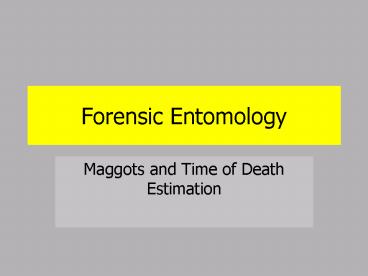Forensic Entomology - PowerPoint PPT Presentation
1 / 20
Title:
Forensic Entomology
Description:
Forensic Entomology Maggots and Time of Death Estimation Arrival First flies search our natural orifices Mouth, nostrils, eyes, ears, genitals Trunk of body is ... – PowerPoint PPT presentation
Number of Views:391
Avg rating:3.0/5.0
Title: Forensic Entomology
1
Forensic Entomology
- Maggots and Time of Death Estimation
2
(No Transcript)
3
Entomology is the Study of Insects Images from
www.afpmb.org/military_entomology/usarmyento/files
/ArmyEntomology.ppt
4
Insect Biology
- Insects are the most diverse and abundant forms
of life on earth. - There are over a million described species- more
than 2/3 of all known organisms - There is more total biomass of insects than of
humans.
5
Medicolegal Forensic Entomology
- Often focuses on violent crimes
- Determination of the time (postmortem interval or
PMI) or site of human death based on
identification of arthropods collected from or
near corpses. - Cases involving possible sudden death
- Traffic accidents with no immediately obvious
cause - Possible criminal misuse of insects
6
Postmortem interval (PMI)
- Forensic Entomology is used to determine time
since death (the time between death and corpse
discovery) - This is called postmortem interval or PMI).
- Other uses include
- movement of the corpse
- manner and cause of death
- association of suspects with the death scene
- detection of toxins, drugs, or even the DNA of
the victim through analysis of insect larvae.
7
Forensic Entomology is Applied Biology
- If it werent for decomposition of all living
things, our world would fill up with dead bodies.
- When an animal dies, female insects will be
attracted to the body. They enter exposed
orifices or wounds and lay eggs or larvae. - A forensic entomologist
- identifies the immature insects
- determines the size and development of the
insects - calculates the growth of the insects and passage
through stages of the life cycle in laboratory - compares the growth against weather conditions to
estimate time of oviposition
8
Image http//www.nlm.nih.gov/visibleproofs
9
Time of Death can be broadly estimated up to
about 36 hours
Temperature Stiffness Time of death
Warm Not stiff Not dead
more
than three hours
Warm Stiff Dead between 3
to 8 hours
Cold Stiff Dead between 8
to 36 hours
Cold Not stiff Dead in more
than 36 hours
10
Differentiate between PMI and Time of Death
- These may not always equate.
- Post mortem interval is restricted to the time
that the corpse or body has been exposed to an
environment which would allow insect activity to
begin. - Closed windows
- Body in box or bag
- Cold temperatures
- Deeper burial
11
Image http//www.nlm.nih.gov/visibleproofs
12
Calculating PMI from Accumulated Degree Hours
(ADH)
From To Temp Hours ADH Cumulative ADH
Egg 1st Instar 70 F 23 23 x 70 1610 ADH 1610
1st Instar 2nd Instar 70 F 27 27 x 70 1890 ADH 1610 1890
2nd Instar 3rd Instar 70 F 22 22 x 70 1540 ADH 16101890 1540
3rd Instar Pupa 70 F 130 130 x 70 9100 ADH 16101890 15409100
Pupa Adult Fly 70 F 143 143 x 70 10010 ADH 16101890 15409100 10010
13
Five Stages of Decomposition Fueled by Insect
Activity.
- Fresh
- Bloat
- Decay
- Post-decay
- Dry (skeletal)
14
Fresh
- Begins at death
- Flies begin to arrive within 10 mins
- Temperature falls to that of the ambient
temperature. - Blow flies
- (Calliphoridae)
- Flesh flies
- (Sarcophagidae)
15
Bloat
- Swells due to gases produced by bacteria
- Temperature rise of the corpse
- Flies still present house flies join
- (Muscidae)
16
Decay
- Gases subside, decomposition fluids seep from
body. - Bacteria and maggots break through the skin.
- Large maggot masses and extreme amounts of fluid.
- Unpleasant odor
- Larvae beginning to pupate.
- Corpse reduced to about 20 of its original mass.
17
Post-Decay
- Carcass reduced to hair, skin, and bones.
- Fly population reduced and replaced by other
arthropods. - Hide beetles are dominant in dry environments.
- Mite and predatory beetle populations increase.
18
Dry (Skeletal)
- Does not always occur especially if corpse is in
a wet region. Maggots will stay longer and hide
beetles will not appear. - In wet environments the hide beetles are replaced
with nabid and reduviid insects. - The corpse is reduced to at least ten percent of
the original mass. - In the last stage (Skeletal Stage), only bone and
hair remain.
19
Arrival
- First flies search our natural orifices
- Mouth, nostrils, eyes, ears, genitals
- Trunk of body is invaded later
- This can determine foul play
20
Factors that Affect Rate
- The following things can affect the rate of
growth - Drugs present in the body
- Temperature
- Location of the body (urban/rural determines
species)































